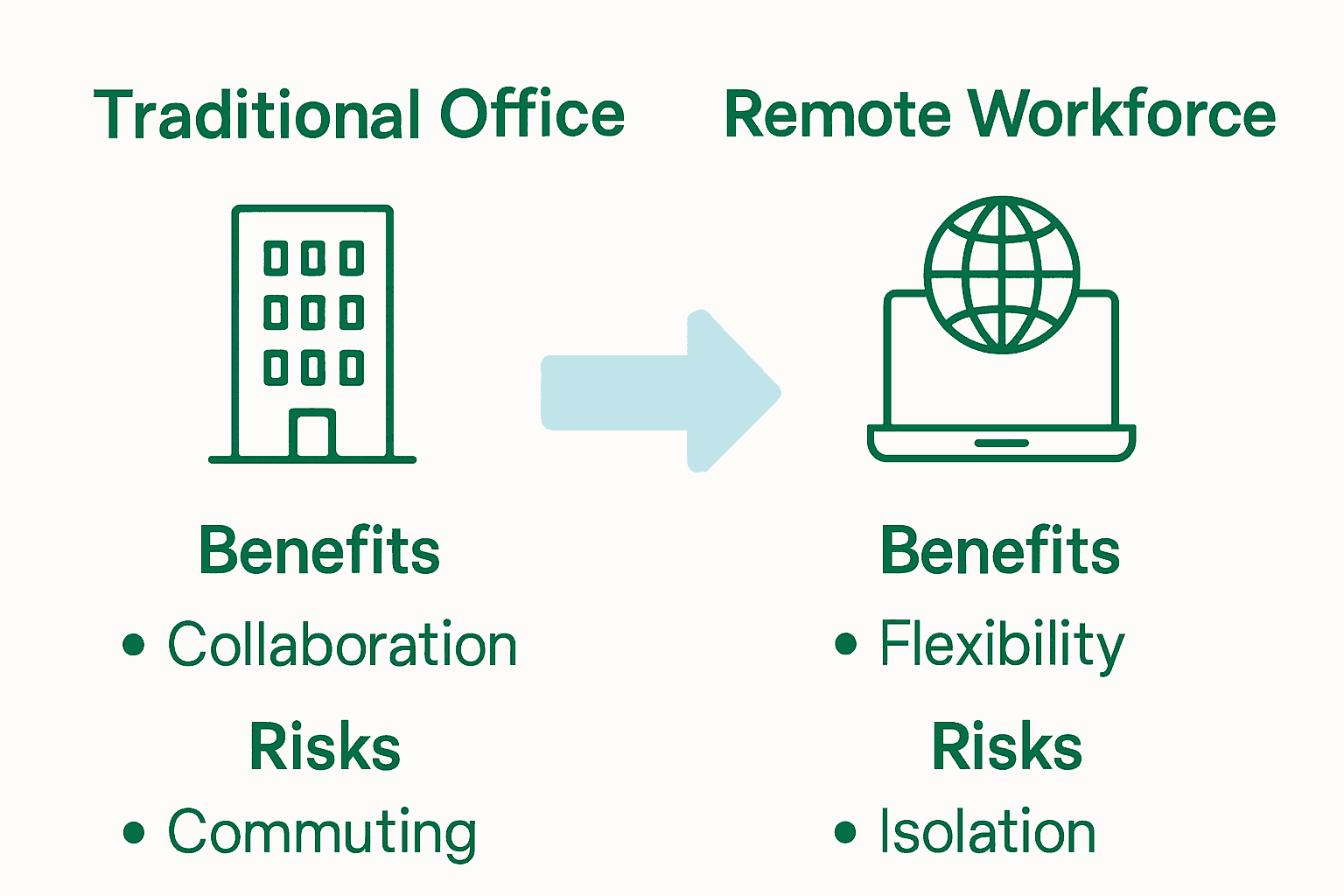The shift toward a remote workforce is more than a trend, with over 40 percent of american workers now operating outside traditional office settings. This rapid transformation has reshaped expectations for how teams collaborate and reach their goals. As businesses across the country adapt to new technologies and flexible work models, understanding the core concepts and proven benefits of remote work becomes essential for every company aiming to stay competitive and resilient.
Defining Remote Workforce and Core Concepts
Remote workforce represents a transformative approach to work where employees perform their professional responsibilities from locations outside traditional office environments. This flexible work model leverages digital technologies to enable team collaboration, communication, and productivity across geographic boundaries.
At its core, remote work allows professionals to complete tasks and deliver results without being physically present in a centralized workspace. The concept encompasses various arrangements from fully distributed teams to hybrid models where employees split time between home and office settings. According to Gartner, remote work can be temporary or permanent, part-time or full-time, and requires comprehensive policies governing equipment usage, network security, and performance expectations.
Key characteristics of a remote workforce include:
- Geographical flexibility for employees
- Technology-enabled communication platforms
- Performance measurement based on outcomes rather than physical presence
- Reduced overhead costs for organizations
- Enhanced work-life balance opportunities
The evolution of remote workforce strategies has been significantly accelerated by technological advancements. Modern cloud computing, collaborative software, and secure communication tools have transformed how businesses approach workforce management. Explore our guide on IT outsourcing trends to understand how digital infrastructure supports these innovative work models.
Understanding remote workforce dynamics requires recognizing both its potential benefits and inherent challenges. While offering unprecedented flexibility, successful implementation demands robust technological infrastructure, clear communication protocols, and strategic performance management approaches. Organizations must design comprehensive frameworks that address technological, operational, and human factors to create effective remote work environments.

Types of Remote Workforce Models
Remote workforce models have evolved to meet diverse business needs, offering organizations flexible strategies for workforce management. These models range from fully distributed teams to hybrid arrangements that balance remote and in-office work, providing companies with unprecedented adaptability in structuring their workforce.
Fully Remote Teams represent the most comprehensive remote work model, where employees work exclusively from locations outside traditional office environments. This approach eliminates geographic constraints, enabling businesses to recruit talent globally and reduce operational overhead. Companies can build teams without physical location limitations, tapping into international talent pools and creating truly global workforces.
Key remote workforce models include:
- Fully Remote: 100% distributed workforce
- Hybrid Remote: Combination of in-office and remote work
- Flexible Remote: Employees choose work locations
- Telecommuting: Periodic remote work arrangements
- Virtual Team: Digitally connected workforce across multiple locations
The Hybrid Remote Model offers a balanced approach, allowing employees to split time between home and office environments. This model provides flexibility while maintaining some in-person collaboration. Explore our essential outsourcing best practices to understand how organizations can effectively implement these workforce strategies.
Understanding these models requires recognizing that no single approach suits every organization. Businesses must assess their specific operational requirements, technological infrastructure, and team dynamics to design a remote workforce strategy that maximizes productivity, employee satisfaction, and organizational efficiency.
 The most successful implementations integrate clear communication protocols, robust technological support, and performance management frameworks tailored to each unique workforce model.
The most successful implementations integrate clear communication protocols, robust technological support, and performance management frameworks tailored to each unique workforce model.
Key Features and Benefits for Businesses
Remote workforce strategies offer transformative advantages for businesses seeking to optimize operational efficiency, reduce costs, and enhance organizational flexibility. By reimagining traditional work structures, companies can unlock significant strategic benefits that extend far beyond conventional workplace models.
Cost Reduction emerges as a primary benefit of remote workforce implementation. Organizations can dramatically decrease overhead expenses associated with physical office spaces, including rent, utilities, equipment maintenance, and infrastructure costs. These savings can be redirected toward core business growth initiatives, technological investments, and talent acquisition strategies.
Key benefits for businesses include:
- Expanded global talent acquisition capabilities
- Reduced operational and infrastructure expenses
- Enhanced employee productivity and satisfaction
- Improved business continuity and resilience
- Increased organizational agility and adaptability
The Talent Acquisition Advantage allows businesses to recruit top professionals without geographic limitations. This approach enables companies to build diverse, high-performing teams by accessing talent pools worldwide, transcending traditional recruitment constraints. Explore our key reasons to outsource IT for business growth to understand how strategic workforce models can drive organizational success.
Beyond economic considerations, remote workforce models contribute to environmental sustainability by reducing commuter traffic and associated carbon emissions. By enabling employees to work from diverse locations, businesses can simultaneously achieve operational efficiency, employee satisfaction, and contribute to broader ecological conservation efforts.
Successful implementation requires robust technological infrastructure, clear performance management protocols, and a strategic approach to maintaining team cohesion and organizational culture.
Implementing and Managing Remote Teams
Successful implementation of remote teams requires a strategic approach that goes beyond traditional management techniques. Organizations must develop comprehensive frameworks that address technological infrastructure, communication protocols, performance management, and team culture to create effective and productive remote work environments.
Digital Infrastructure forms the foundation of successful remote team management. Companies need to invest in robust cloud-based collaboration platforms, secure communication tools, and integrated project management systems that enable seamless interaction and transparent workflow tracking. These technological solutions must provide real-time communication channels, document sharing capabilities, and performance monitoring features that bridge geographical distances.
Key strategies for managing remote teams include:
- Establishing clear performance expectations
- Implementing comprehensive communication protocols
- Utilizing advanced digital collaboration platforms
- Creating structured accountability mechanisms
- Developing robust cybersecurity frameworks
- Fostering a culture of trust and transparency
Performance management in remote settings demands a results-oriented approach that focuses on outcomes rather than traditional time-based monitoring. Managers must develop precise metrics, implement regular check-ins, and create transparent evaluation systems that measure productivity and contribution objectively. Explore our guide on monitoring outsourced staff for maximum efficiency to understand sophisticated tracking and evaluation techniques.
Building a cohesive remote team culture requires intentional effort to maintain human connections and organizational alignment. Regular virtual team-building activities, transparent communication channels, and inclusive digital platforms can help mitigate the potential isolation and disconnection associated with remote work. Successful organizations recognize that effective remote team management is an ongoing process of adaptation, continuous learning, and strategic technological integration.
Cost, Risks, and Compliance Considerations
Navigating the complex landscape of remote workforce implementation requires a comprehensive understanding of financial, operational, and legal challenges. Organizations must develop strategic approaches that balance potential cost savings with robust risk management and regulatory compliance protocols.
Financial Considerations extend beyond traditional cost reduction metrics. While remote work can significantly decrease overhead expenses related to physical office spaces, businesses must account for new investment requirements such as advanced technological infrastructure, secure digital communication platforms, and comprehensive employee equipment provisioning. These initial investments can be substantial but often yield long-term operational efficiency and cost optimization.
Key risk and compliance factors include:
- Cybersecurity vulnerability management
- Data privacy and protection regulations
- Cross-jurisdictional labor law compliance
- Equipment and technology infrastructure costs
- Employee classification and tax implications
- Information security risk assessment
The Cybersecurity Imperative represents a critical aspect of remote workforce risk management. Distributed work environments introduce complex digital security challenges that demand sophisticated technological safeguards and comprehensive employee training programs. Explore our guide on outsourcing repetitive tasks for seamless efficiency to understand how strategic task allocation can mitigate potential security risks.
Compensating for potential compliance risks requires a multilayered approach that combines technological solutions, comprehensive policy frameworks, and continuous monitoring. Organizations must develop adaptable strategies that can navigate evolving regulatory landscapes, protect sensitive information, and maintain operational integrity across diverse geographic and technological contexts. Successful remote workforce implementation demands proactive risk management, strategic financial planning, and a commitment to maintaining rigorous compliance standards.
Unlock Your Business Potential with Expert Remote Workforce Solutions
Managing a remote workforce comes with its own set of challenges like securing digital infrastructure, maintaining team productivity, and complying with evolving regulations. If you are looking to harness the true benefits of remote work such as cost reduction, global talent access, and enhanced operational flexibility, you need a strategic partner who understands these complexities. NineArchs LLC specializes in tailored remote workforce solutions including virtual assistance, IT outsourcing, and business process outsourcing that help you overcome these challenges smoothly and cost-effectively.

Don’t let the complexities of remote workforce management hold your business back. Experience how our professional and scalable services can transform your approach to remote teams, boost productivity, and improve overall business continuity. Contact us today at NineArchs Contact to start building a customizable remote workforce strategy designed for your growth. Learn more about outsourcing best practices and how to monitor a remote team effectively for optimal results.
Frequently Asked Questions
What is a remote workforce?
A remote workforce refers to an arrangement where employees work from locations outside traditional office settings, utilizing digital technologies for communication and collaboration.
What are the types of remote workforce models?
Types of remote workforce models include fully remote teams, hybrid remote setups, flexible remote arrangements, telecommuting, and virtual teams, each offering varying degrees of remote work flexibility.
What are the key benefits of implementing a remote workforce strategy?
Key benefits include cost reduction, expanded global talent acquisition, enhanced employee productivity and satisfaction, improved business continuity, and increased organizational agility.
How can organizations effectively manage remote teams?
Organizations can manage remote teams by establishing clear performance expectations, utilizing digital collaboration tools, creating structured accountability mechanisms, and fostering a culture of trust and transparency.









